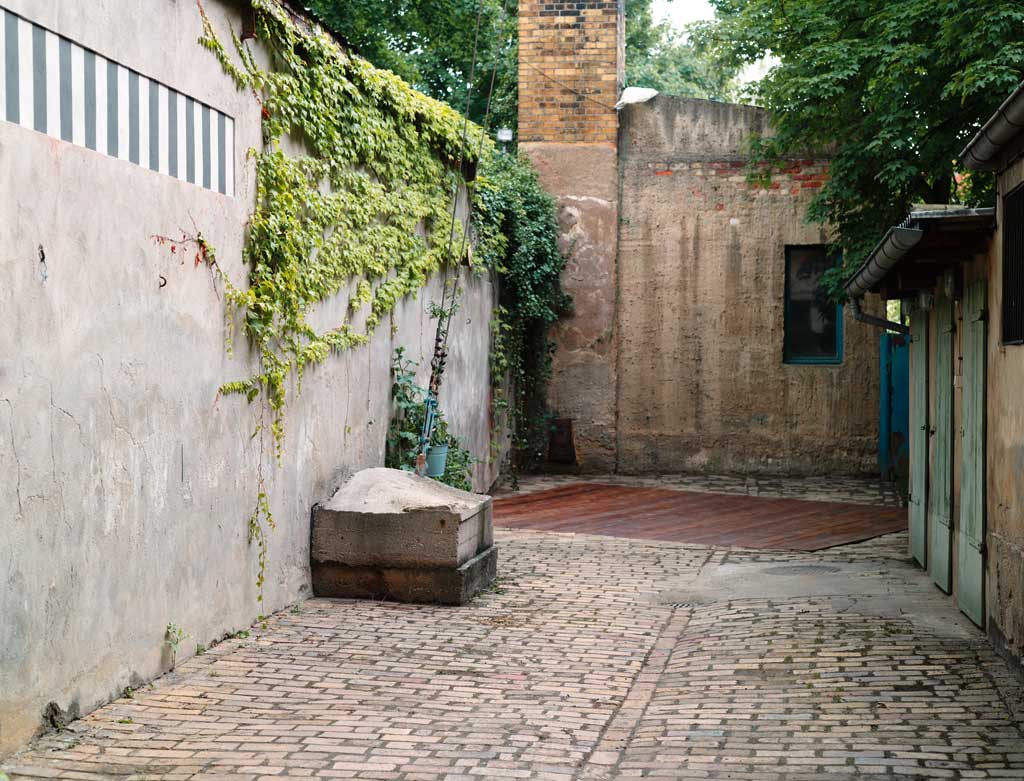Small marks and covered traces of lettering on the walls of one of the stairwells generated the beginning of an extensive investigation by the four authors, leading to various artistic ap- proaches. Poring over architectural records, uncovering the written characters, installing ar- chitectural fragments, and above all, an examination aimed at the alteration of the culture of remembrance have become part of the overall project, which will be continued.
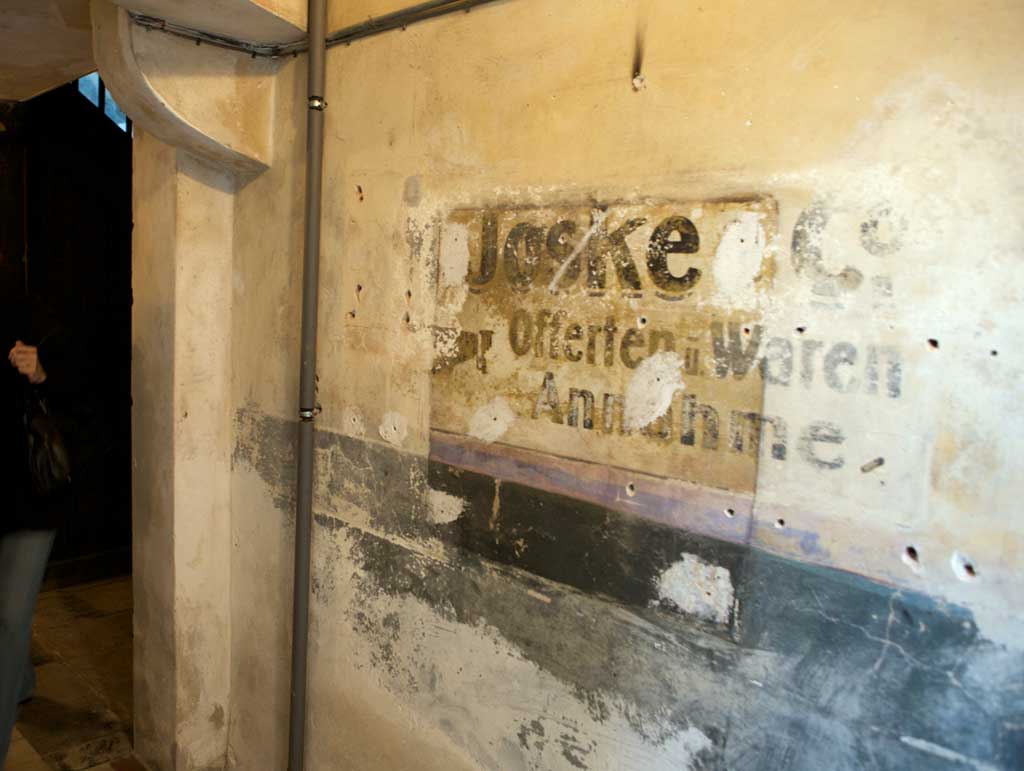
The buildings of the former Jewish department store Joske extend from Karl-Heine-Street 43 to Walther-Heinze-Street 3 in Leipzig-Plagwitz. These two houses were connected by a shared court. The sales area was located solely at ground level, on the ground floors of the still existing (residential) houses as well as in two adjoining halls, built in 1912 and 19
History
In the west of Leipzig, the historical development of this district can be recognized easily in architecture and urbanism – they tell of the age of industrialization, urbanization, and ultimately the downfall of the era. Partly refurbished industrial buildings bear the distinguished brickwork architecture and chimneys. From afar, they reveal the nature of this district, which was indeed a special one: a coexistence of factories, employee tenements, and employer mansions. Such a district – which was once systematically evacuated – can neither be revitalized from one day to the next, but neither can its historic references be annihilated, despite the demolition cra- ze and cheap restorations. These references are not the kind for which wreaths are laid down or monuments raised. They are small signs that can be followed, if one wishes to discover more about a particular history. 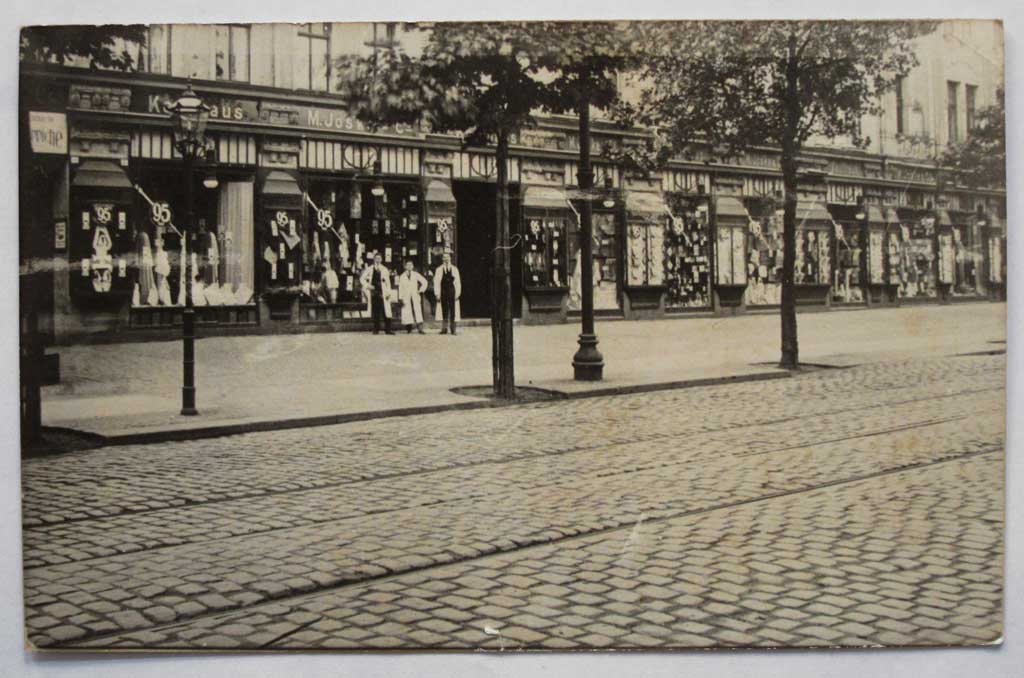 The appearance of the row of houses Karl-Heine-Street 43-45, and around the corner on Walther-Heinze-Street 3, partly renovated, partly (one might assume) untouched since the end of the war, hardly conveys that this block used to accommodate a cohesive and flourishing business: Plagwitz ́s first department store. The Jewish merchant family Joske, that came to Saxony from East-Brandenburg at the end of the 19th century, established itself here in 1904 with a branch of their main store on Windmühlenstraße. The last extensive architectural remodeling also relevant to this project was undertaken in the 1920s. The appointed architect was Wilhelm Haller, who hat already realized numerous constructions in Leipzig and its vicinity, amongst which were mainly religious buildings but also residential and business houses. During the 20s, the influence of the New Objectivity is increasingly noticeable in his work. Particularly his later residential estates built in Tel Aviv in the Bauhaus style became famous. Wilhelm Haller was now commissioned to create a plain and compact front in place of the „terrible ornamentation on the pillars and above“ (from a letter by the Company M. Joske & Co., from 1927, taken from the construction document, Leipzig Building Authority). He achieved this primarily by mounting a striped bordure above the shop windows, which stretched over the entire block. Haller ́s reconstruction, highly praised by trade journals, was inaugurated in 1929 and was not to have a long life span as a department store. During the 1930s, Joske experienced what all Jewish businesses experienced: systematically, work was made impossible for them. Driven into bankruptcy, they were forced to close the department store in Plagwitz in 1934. The building was put up for compulsory auction in 1993. Some members of the family managed to emigrate to France and Palestine, most of them, especially the women, were deported to the east and murdered.
The appearance of the row of houses Karl-Heine-Street 43-45, and around the corner on Walther-Heinze-Street 3, partly renovated, partly (one might assume) untouched since the end of the war, hardly conveys that this block used to accommodate a cohesive and flourishing business: Plagwitz ́s first department store. The Jewish merchant family Joske, that came to Saxony from East-Brandenburg at the end of the 19th century, established itself here in 1904 with a branch of their main store on Windmühlenstraße. The last extensive architectural remodeling also relevant to this project was undertaken in the 1920s. The appointed architect was Wilhelm Haller, who hat already realized numerous constructions in Leipzig and its vicinity, amongst which were mainly religious buildings but also residential and business houses. During the 20s, the influence of the New Objectivity is increasingly noticeable in his work. Particularly his later residential estates built in Tel Aviv in the Bauhaus style became famous. Wilhelm Haller was now commissioned to create a plain and compact front in place of the „terrible ornamentation on the pillars and above“ (from a letter by the Company M. Joske & Co., from 1927, taken from the construction document, Leipzig Building Authority). He achieved this primarily by mounting a striped bordure above the shop windows, which stretched over the entire block. Haller ́s reconstruction, highly praised by trade journals, was inaugurated in 1929 and was not to have a long life span as a department store. During the 1930s, Joske experienced what all Jewish businesses experienced: systematically, work was made impossible for them. Driven into bankruptcy, they were forced to close the department store in Plagwitz in 1934. The building was put up for compulsory auction in 1993. Some members of the family managed to emigrate to France and Palestine, most of them, especially the women, were deported to the east and murdered.
Stripes
A significant detail of Wilhelm Haller ́s reconstructions of 1929 was a stripe bordure above the display windows. This no longer existent detail once spanned the entire complex of buildings, thus consolidating the diversely fashioned houses. Based on a black and white photograph, on which the stripes appear to be gray and white, this detail is picked up and installed on the level building in Walther-Heinze-Street 3 and on the front of Karl-Heine-Street 43 in a fragmentary fashion, marking the beginning and the end of the premises. A third stripe extends into the courtyard of Karl-Heine-Street 43, in order to connect these two points. To install the stripes, the rendering was removed and reapplied in a thinner coat, which was then painted an anthracite gray.
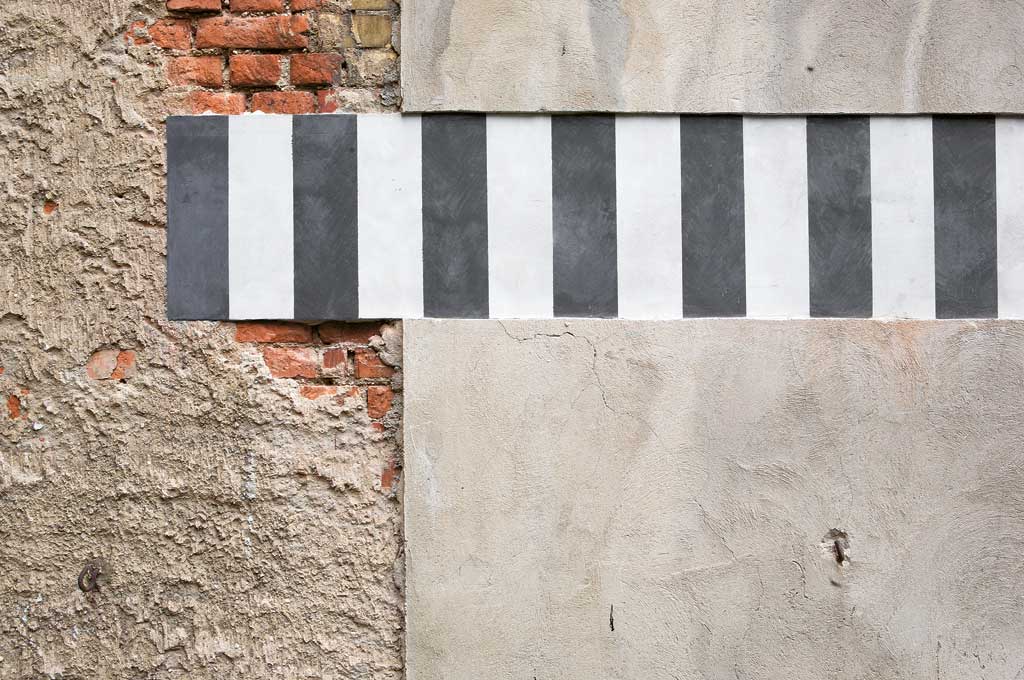
The combination of dark gray and light gray refers to the source – the photograph –, shows the intervention even more clearly, and demonstrates opposition to the mania of reconstructing an original down to the last detail. Countersinking the bordure within the rendering insinuates an archaeological excavation. In its simplicity and „objectivity“, the bordure sets itself apart from its cluttered surroundings and refers to its primordial period of origin and the ideas of the Bauhaus, Modernism, and their utopias.
Posters
The installation of the stripes and the alteration of the courtyard in Karl-Heine-Street 43 are accompanied by a poster edition. They are pasted on the gates of the houses and are replaced regularly. The posters depict historic photographs as well as text excerpts and floor plans from the construction documents which refer to the building ́s history. They are an elaboration on the subject of the facade installation and give shape to a vivid remembrance culture. The constant replacement of posters and poster motifs allows content changes and spontaneous reactions to specific dates or happenings.
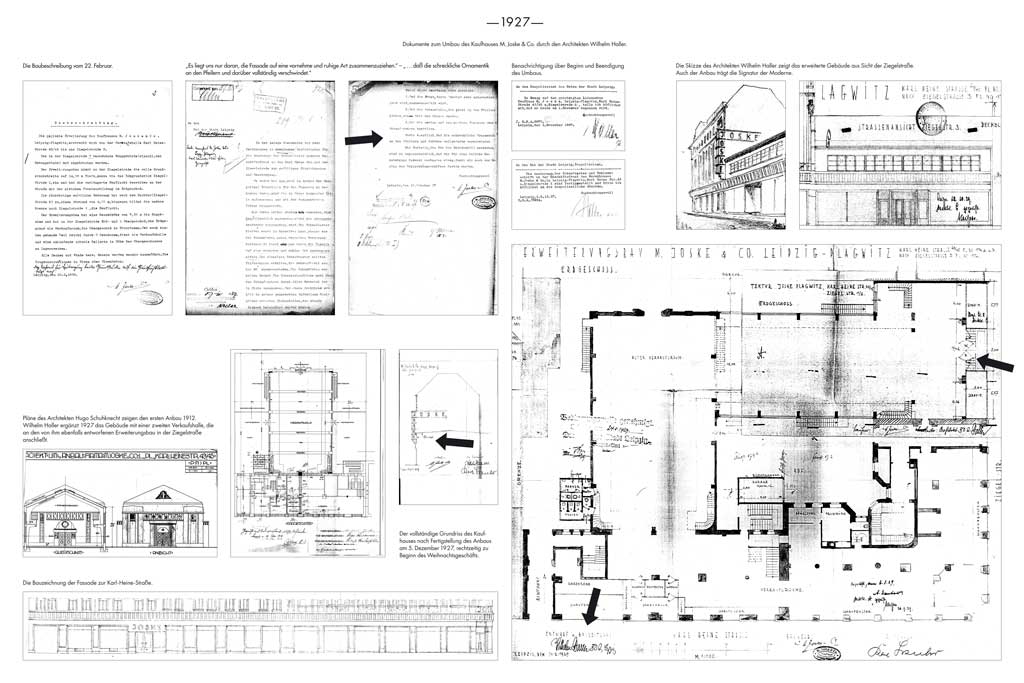
The constant replacement of posters and poster motifs allows content changes and spontaneous reactions to specific dates or happenings.
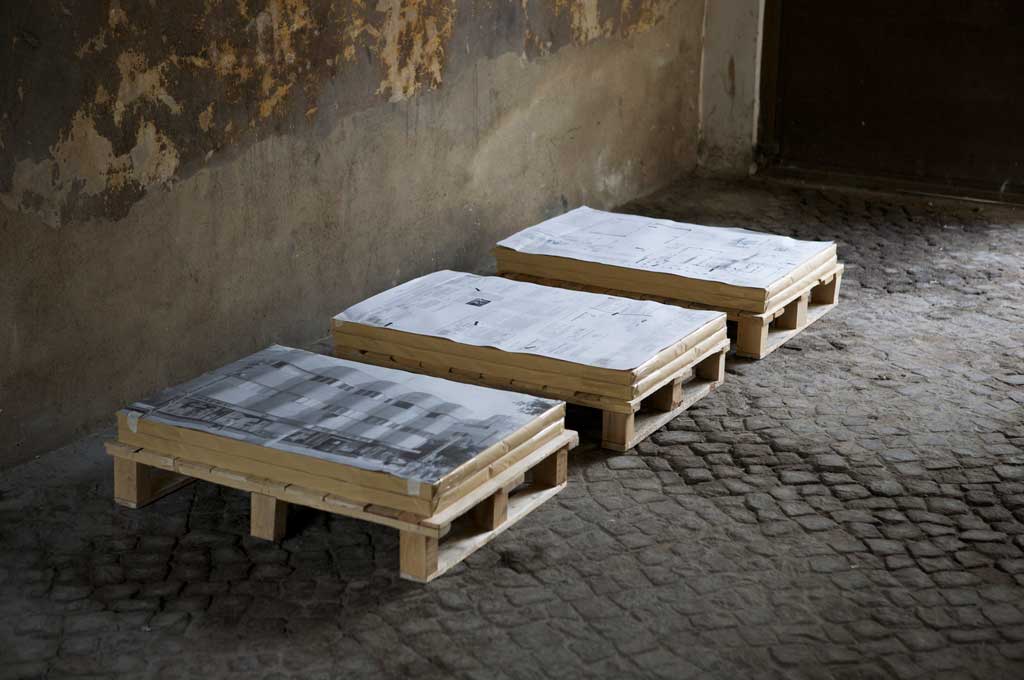
The sculptural presence of the stacks of posters and their large quantity give reference to the continuous renewal on the face of the building. Each poster is reproduced in large amounts, in order to make the expiration of this action neither definite nor conceivable.
Space
Within the inner courtyard of Karl-Heine-Street 43, next to the stripes, a small garden and a wooden plane embedded in the old brick floor, were created. The courtyard is used as a place of communication for guests of the “Kaufhaus Joske”, and the space gives room to topical events (readings, concerts, screenings, and temporary sculptures). Artists working in various media are invited to react to this place with an awareness of its history.
